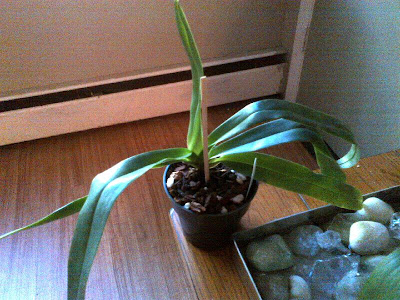I have been finding that lately the media in my orchid pots has been drying way too quickly. I am finding myself watering my orchids every single day. Previously, I was using my new mini tower fan on its lowest regular setting (setting 1), but found that maybe the best solution was to start using it on Breeze Mode. Don't get me wrong; I don't mind watering the plants so regularly, but from everything I have read, the media is supposed to stay moist for at least a couple of days. This is particularly important for Snow White, who is still adjusting to being transplanted from Sphagnum Moss to a much drier bark mix. I'd like to see if I can reduce the need for watering to about 2-3 times per week. I think that would be a great compromise.
From my research, in the wild, epitphytes get rained on several times per week and dry out quickly with tropical breezes. For the most part, this cycle repeats itself week after week. So having the media dry out pretty quickly should not be a bad thing, but not to the point that the roots become entirely dessicated regularly and the media is bone dry in a matter of a few hours.
Tomorrow I will water them as I have been doing and keep the fan on Breeze Mode for the duration of the day. I will then test to see if the media is still drying up completely or if some moisture is retained in the lower layers of substrate for a longer period of time.
Update
I watered the orchids this morning at 9:00 am. I left the fan on Breeze Mode, and by noon, the roots were still moist as pictured below:
I realized the media was a bit too loosely packed since there were some air pockets entirely devoid of media altogether. I filled in the holes, but was careful to still keep the bark mix fairly loose. This small change should help in retaining additional moisture as well.
From my research, in the wild, epitphytes get rained on several times per week and dry out quickly with tropical breezes. For the most part, this cycle repeats itself week after week. So having the media dry out pretty quickly should not be a bad thing, but not to the point that the roots become entirely dessicated regularly and the media is bone dry in a matter of a few hours.
Tomorrow I will water them as I have been doing and keep the fan on Breeze Mode for the duration of the day. I will then test to see if the media is still drying up completely or if some moisture is retained in the lower layers of substrate for a longer period of time.
______________________________________________________
Update
I watered the orchids this morning at 9:00 am. I left the fan on Breeze Mode, and by noon, the roots were still moist as pictured below:
 |
| Snow White's Roots 3 hrs after watering |
I realized the media was a bit too loosely packed since there were some air pockets entirely devoid of media altogether. I filled in the holes, but was careful to still keep the bark mix fairly loose. This small change should help in retaining additional moisture as well.




















